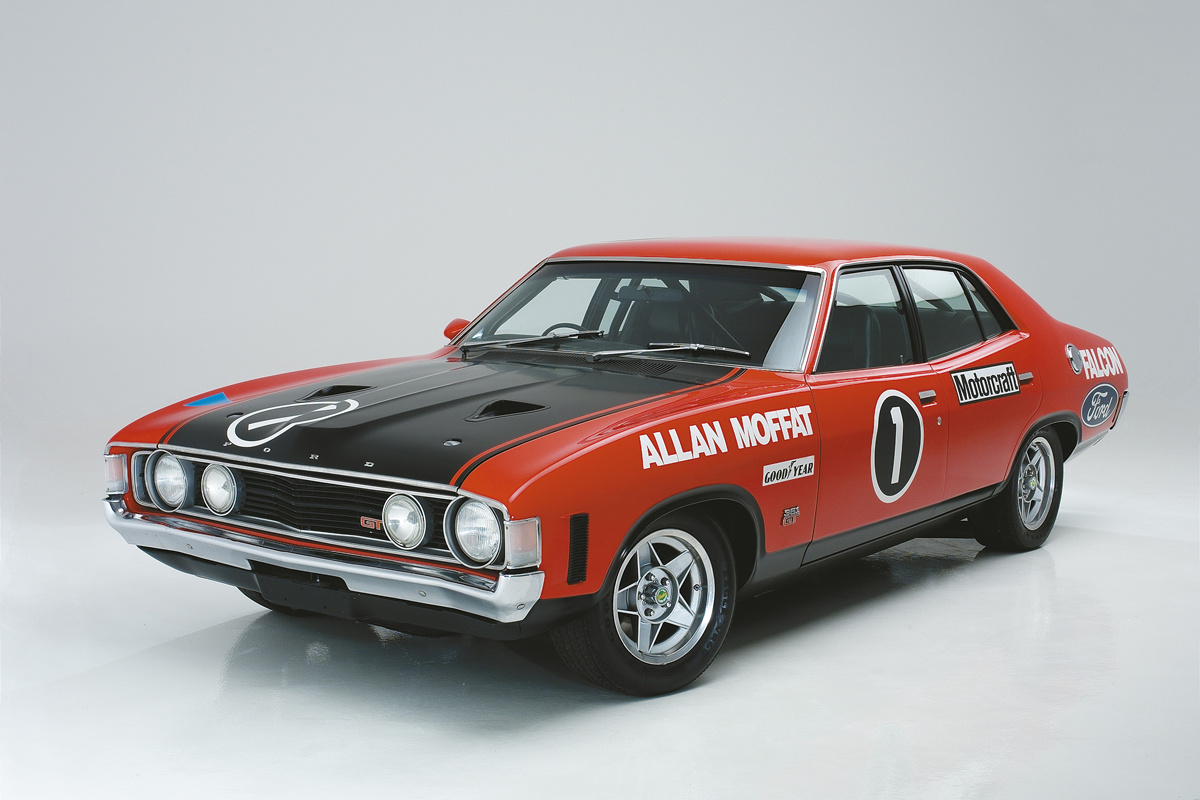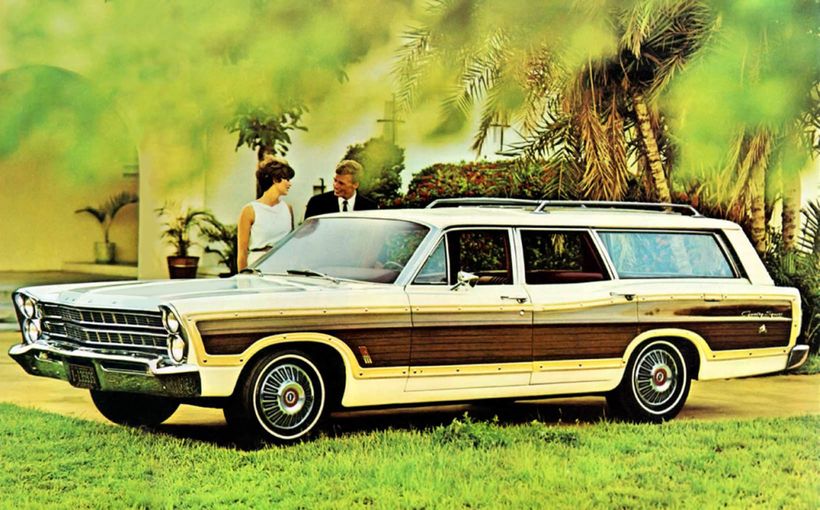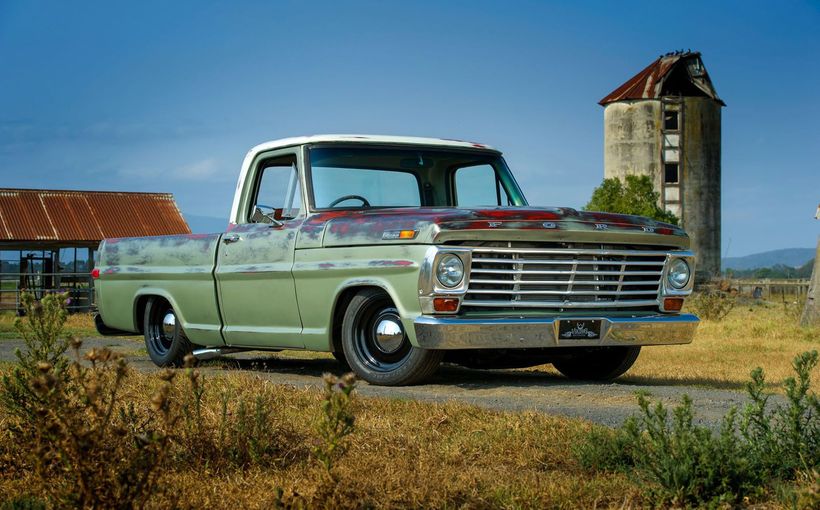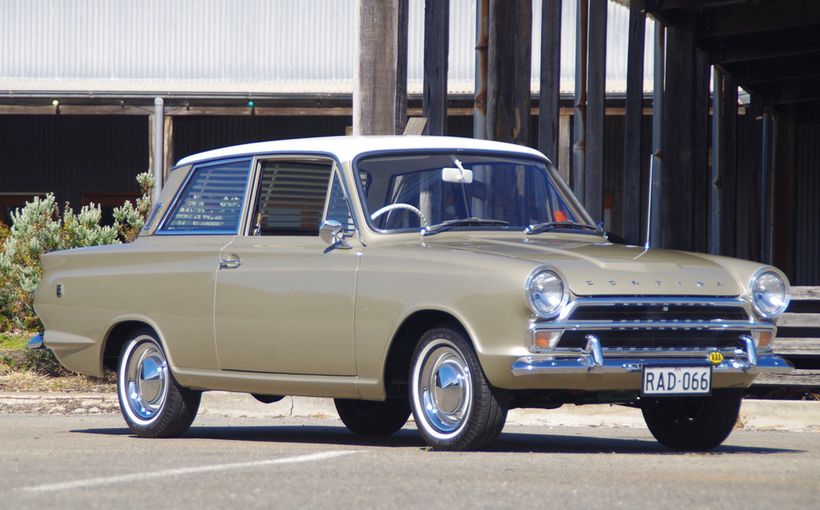XA Falcon GT-HO Phase IV: Was it destined to fail at Bathurst?
By
MarkOastler -
16 December 2014

The fourth generation of the Falcon GT-HO certainly looked the goods with its superb 15 x 7-inch Globe alloy wheels and dressed in full works team war paint. Ford was well advanced with construction of its Phase IV race cars and had already sent one production car down the assembly line when the program was axed. One of the three race cars was rallied by Bruce Hodgson in 1973 before being sold and later written-off in a road accident. Fortunately, the remaining two and the sole production car survived and are now in private ownership. This is the magnificent Phase IV owned by Queensland collector David Bowden, which was fully prepped by Ford for racing. Image: The Bowden Collection
It would have been the greatest GT-HO of them all. A political storm ensured that the Phase IV never competed in the big race it was designed to win, but history suggests it was destined to fail had it competed at Bathurst in the 1972 Hardie-Ferodo 500.
Not that there were any weaknesses in the Phase IV. Although it featured the all new styling of the XA Falcon range, under the skin the fourth generation of the GT-HO was another evolution of the Bathurst-winning breed with refinements made to improve performance, durability and handling.
However, what crippled the XY GT-HO Phase IIIs (rushed back into service at Bathurst in 1972) and would have done the same to the Phase IV, were tyres and brake pads.
Heavy showers that year left the Ford works team in a quandary over which way to go with tyres, as this was the first wet Bathurst 500. Given that the showers were forecast to ease, team boss Howard Marsden took an each-way bet by fitting lightly-grooved intermediates to the works Phase IIIs driven by Allan Moffat and Fred Gibson. Other Ford runners followed.
This fateful decision ensured that the big V8 Fords really struggled in the early laps, with water streaming across the circuit in treacherous places. The smaller and lighter Torana GTR XU-1s led by eventual race winner Peter Brock made the GT-HOs look like elephants on ice-skates.
Drivers feared for their safety in those early laps, particularly if they strayed off the slightly drier racing line that started to emerge and into the wet sections of track which were like black ice. Fred Gibson did and paid a heavy price, hitting the bank at Skyline on lap 22 and flipping his big red Ford onto its roof.

1972 was the first time the annual Hardie-Ferodo 500 was held in wet conditions. Here Ford works driver Allan Moffat leads John Goss, John French and Fred Gibson into a slippery Hell Corner moments after the start. If not for the ‘Supercar Scare’ these all would have been new XA GT-HOs. Note the Phase IV’s alloy wheels which had been approved for use on the Phase IIIs in time for Bathurst.
His team-mate Moffat, who for many laps had been involved in a tremendous fight for the lead with Peter Brock’s XU-1, also paid the penalty of getting off the drier line on lap 28 when he suffered a frightening high-speed lose at the top of the Mountain, fortunately without damage.
However, the time lost recovering from this spin put extra pressure on Moffat and his team, resulting in two fumbles during refuelling stops that cost him crucial time penalties.
The other Ford time-bombs waiting to explode were the brake pads. Several unprecedented factors conspired on that cold and wet morning at Mount Panorama to cause disintegration of the brake friction materials, which crippled Moffat’s Phase III and would almost certainly have done the same to a Phase IV had he been driving one.
The first of those factors was the beautiful 15 x 7-inch five-spoke alloy wheel made by Globe Industries in South Australia. Inspired by the famous Ferrari Daytona wheel, it was specially designed by Globe’s Kevin Drage for the stillborn Phase IV but was given late approval to be used on the Phase IIIs instead.
The ‘Bathurst’ wheel, as it became known, brought numerous benefits. It was stronger yet lighter than Ford’s standard 14 x 6-inch steel wheel, resulting in a big drop in unsprung weight. It was also one inch (25mm) larger in both diameter and rim width, allowing a switch to the latest low profile ER-60H-15 road radials and new generation of cross-ply race tyres.
Most significant in this context, though, was the alloy wheel’s brake cooling, thanks to improved ventilation and the superior heat dissipation of aluminium over steel. These wheels almost halved the GT-HO’s brake temperatures in racing, from around 850 down to 450 degrees Celsius.

John French approaching The Cutting in his Wild Violet Phase III entered by Queensland Ford dealer Bryan Byrt. French, who drove for the Ford works team the previous year, produced arguably the greatest drive of his career at Bathurst in 1972, overcoming a flat tyre and brake trouble to finish a fighting second to Peter Brock’s Torana XU-1. That year French also set the highest top speed of any Phase III on Conrod Straight at an astonishing 154 mph (246 km/h). The XA Phase IV would have been even faster.
In dry conditions this brake cooling was a big advantage, but in the unprecedented wet conditions at Bathurst in 1972 it became a crippling problem that no-one could have foreseen.
That was because the brake compound, specially developed by race sponsor Hardie-Ferodo for the 1971 race, was designed to operate at extreme temperatures caused by the 14 x 6-inch steel wheels and front spoilers the Phase IIIs ran with that year.
At Bathurst in 1972, though, the same brake compounds ran much cooler because of the wet weather, the superior ventilation of the new Globes and the absence of front spoilers, which Marsden had removed primarily to increase air cooling around the engine’s sump.
As a result, the brake pads never reached their correct operating temperatures, causing the friction material to destabilise and literally fall apart. On Moffat’s car, this resulted in a front left pad wearing right through its steel backing plate, leaving the caliper pistons being ground into the face of the disc rotor!
The works team was left with no choice but to isolate the front left brake by cutting and crimping its steel brake line to get the car home. After 15 minutes of repairs, Moffat was sent back out to limp to a lowly fifth place finish with only the rear drums and one front disc working.
Given that the Phase IV would also have run without a front spoiler and used the same 11.25-inch diameter front disc brake hardware, pad material and Globe wheels, there’s little doubt it would have suffered the same fate.
And if it had failed in its primary role to win the 1972 Bathurst 500, the Phase IV would not be as revered as it is today. Which would have been a travesty, because as you will discover it was to include everything that Ford wanted to do to a GT-HO.

The Phase IV was to be based on the standard XA GT sedan as shown here, with an increase of $740 over the manual GT's $4,845 list price. Apart from the Globe alloy wheels, the Phase IV would have been hard to pick from the standard GT, which lacked the thick side stripes and Super Roo decals of earlier models. Standard equipment was to include the Phase III’s huge 36-gallon fuel tank with a new cut-and-sewn boot carpet to cover it, an HO decal on the console and rolled front and rear mudguard flanges to accept the wider tyres. Air-conditioning, power steering and automatic transmission options were not available.
XA GT-HO: a genuine ‘supercar’
The Phase IV was killed off by a politically motivated and media-driven campaign which has since become known as the ‘Supercar Scare’ of 1972.
An infamous front page newspaper story by Evan Green about the “160 mph supercars” being prepared by Ford, Holden and Chrysler for the Bathurst 500 ignited a political storm over road safety. Politicians had basically had enough of the outdated Bathurst race rules, which each year required car manufacturers to produce at least 200 examples of the cars they wished to race there.
These all had to be sold and registered for road use before they could be approved by governing body CAMS and the race organisers as genuine ‘series production’ cars. By 1972 this approval process had been corrupted by the big three local car makers.
Based on a proven ‘Win on Sunday, sell on Monday’ marketing approach, their obsession with winning Bathurst had become socially unacceptable, particularly given the nation’s soaring road toll.
The pollies warned there would be serious consequences if manufacturing of these ‘supercars’ continued, including threats to review their lucrative government fleet contracts.
Within days, Holden stopped its planned 200-unit production run of V8-engined LJ Torana GTR XU-1s at its Brisbane plant and Ford cancelled a 200-unit Phase IV production run at Broadmeadows when both were poised to commence.
Chrysler was already well advanced with production of its definitive
Hemi Six Pack Charger R/T E49 when the chaos erupted, so enough examples had already been built for it to be accepted for the 1972 Bathurst race before the axe also fell on its high performance program.
In response to this political pressure, motor sport’s governing body CAMS quickly drafted new rules for 1973 that would eliminate the need for car makers to keep producing race cars for the road. And with that went the Bathurst supercars.
Even so, it’s timely to reflect on what an extraordinary high performance vehicle the XA Falcon GT-HO Phase IV would have been had it become a production reality.

The GT-HO Phase IV race cars under construction in 1972 at Ford’s high security special vehicles division at Lot 6 Mahoneys Road, not far from the company’s head office in Melbourne. These cars, which started life as Brambles Red XA GTs, were being built to Phase IV specifications. The cars on stands were for Allan Moffat and Fred Gibson to drive. The third car on 12-slotters, which had the full roll cage, rear seat bulkhead plate and 36-gallon tank installed, was set aside as a spare. Note how all the GT road car parts not required for racing were removed and pushed aside, waiting to be returned to the production line or spare parts inventory.
It would have been a ‘supercar’ in every dimension, because CAMS and Ford management were keen to tidy up the annual race homologation process for these small-volume Bathurst cars. Only one batch of 200 GT-HO Phase IVs would be built and (apart from a roll cage) each would have been fitted with everything the race cars had – including the engine.
When interviewed in 2001, Howard Marsden confirmed that every Phase IV that went down the assembly line was to be equipped with what Ford called a ‘QC’ (Quality Control) engine produced on a special mini-assembly line at Ford’s Geelong engine plant, under former Repco engineer Bill Santuccione.
Ford had previously offered these virtually hand-built engines to Phase III racers that requested them for the bargain basement price of $250. Detailed blueprinting within factory tolerances under the factory’s QC process turned production engines into genuine Bathurst race engines. Ford certainly got value from this investment on the Mountain in 1971, with Phase IIIs claiming 1-2-3 outright and the top eight places in class.
However, in each of the new XA GT-HOs these QC engines had to be fitted as standard equipment, hence the need for a mini-assembly line to both authenticate Ford’s ‘series production’ claim and produce a batch of 200 engines in the limited time available to meet production deadlines.
Despite repeated denials by Ford staff over the decades, factory parts listings confirm that the Phase IV’s 351 cid (5.8 litre) Cleveland V8 was to be based on a special 250-unit order of Boss 351s imported from the US, featuring rugged four-bolt main bearing blocks that could withstand the 7000 rpm-plus planned for this engine in racing.

One of the Ford Special Vehicle’s mechanics hard at work on Phase IV race preparation. Note the substantial roll cage built into each of the works cars, to provide unmatched driver protection and a more rigid chassis. Note also the big Graviner integrated fire extinguisher system. This was a first for Series Production racing in Australia and by 1972 considered a crucial safety device, given that these cars were capable of tremendous speeds and were carrying large fuel loads.
Although the Phase III’s famous ‘shaker’ air intake was gone, a big 780 cfm four barrel Holley was to remain with a reworked air cleaner housing to provide much improved peripheral breathing, matched to an aluminium dual-plane ‘Buddy Bar’ inlet manifold.
The Phase IV heads were to benefit greatly from the QC process, with substantial machining of the 4V combustion chambers around the inlet valve to improve gas flow. Close attention was also paid to eliminating any casting roughness in the combustion chambers, which created hot spots and detonation in numerous non-QC Phase III engines.
This machining work resulted in a slight drop in the compression ratio with a corresponding increase in torque being accessed lower in the rev range than the peakier Phase III.
Stronger ‘super duty’ con-rod bolts were also specified given the higher rev tolerance along with a much needed 1.5 litre increase in oil capacity, by the addition of two teardrop-shaped ‘ears’ welded to each side of the sump adjacent to the oil pump pick-up. ?At the time, higher G force loadings caused by greater cornering speeds were starting to cause serious oil surge in the sump, starving the pick-up of oil and causing numerous blow-ups in racing Phase IIIs.
The ears’ aerodynamic shape was also designed to help tame rising oil temperatures by harnessing the fresh air flowing under the car. The baffled sump included a windage tray to minimising oil frothing caused by crankshaft rotation.
Hand-fabricated exhaust headers, developed specifically for the Phase IV by Ford and HM Headers, featured big 2.25-inch primaries to extract even more top-end power matched to a larger diameter and freer-flowing secondary exhaust system.
A special dual-point distributor with built-in rev limiter (and possibly non-breaker point electronic ignition later on) was also specified, along with a unique heavy duty harmonic balancer.

Another view of the factory team’s Phase IVs being prepared for Bathurst duties. Interesting to compare the size of the cavernous 36-gallon (163-litre) ‘Bathurst’ tank on the left which was to replace the GT’s standard tank, with integral spare wheel well, on the right. On the race cars these were foam-filled to control fuel surge, with a safety valve installed in the filler neck to stop spillage in a collision or roll-over.
Improved engine cooling was to come from the XA’s new larger capacity, four-core, cross-flow radiator and a special cooling fan with seven blades that twisted flat above a certain engine speed, to reduce power loss and the risk of a broken fan belt. This heavy duty radiator and fan combo was shared with V8 Falcons equipped with the factory’s air conditioning option.
The rest of the drivetrain was evolutionary, but also unique to the Phase IV. Ford’s top loader four-speed gearbox with long extension housing was matched to a shorter and larger diameter (3.5-inch) heavy duty tail-shaft assembly to eliminate ‘whip’ at high engine speeds.
The Phase IV’s live rear axle was also unique because of the XA’s slightly wider track width, featuring rugged 31-spline axle shafts, nine-inch crown wheel and pinion, Detroit Locker centre and big 2.5-inch wide finned drum brakes.
Although Ford’s wide-ratio top loader and tall 3.0:1 final drive were to be supplied as standard equipment, a choice of shorter diff ratios plus the close-ratio gearbox with its much taller first gear would also have been homologated for racing.
According to Santuccione, these QC Phase IV engines would have provided phenomenal performance and been potential Bathurst-winning engines straight off the showroom floor, nudging 400 bhp (300 kW) with 390 ft/lbs of torque (526 Nm) available across a wider and more flexible rev range.
If those figures sounds tame compared to the massive 576 bhp (430 kW) and 546 ft/lbs (740 Nm) claimed for today’s Aussie muscle car king, the supercharged 6.2 litre HSV GTS, keep in mind the XA’s kerb weight was only 1385 kgs compared to 1880 kgs for the GTS.

The XA GT-HO Phase IV was a fantastic-looking muscle car, particularly in full race trim like David Bowden’s with the big Globe wheels, full roll cage and open exhausts. However, a Ford family sedan being built for road use with a Detroit Locker diff, 36-gallon tank and 400bhp V8 Bathurst race engine as standard equipment looked to the politicians like lunatics were running the asylum. The supercar furore shocked Ford Australia. It dropped high performance like a hot brake pad and was never quite the same again. Image: The Bowden Collection
That’s a difference of nearly 500 kgs, or half a tonne, which is a lot of dead weight to get moving. Not surprisingly, the Phase IV would have had a superior power-to-weight ratio with only 3.46 kgs/kW compared to the GTS’s 4.37 kgs/kW.
So in a straight line the Phase IV would still give today’s muscle car yardstick a run for its money. And let’s not forget there was no supercharger, electronic engine management or traction control in the GT-HO – we’re talking downdraught Holley four-barrel, breaker-point ignition and Detroit Locker diff.
A sign of Ford’s confidence in the strength of this engine was that the Phase IVs were to be equipped with 8000 rpm tachometers as standard equipment. Even so, the GT-HO’s high performance QC engine would be factory-fitted with a 6200 rpm rev limiter. With 24.4 mph (39 km/h) per 1000 rpm using the standard wide-ratio gearbox and 3.0:1 diff, that would have capped the top speed at 151 mph (242 km/h).
However, Marsden and Santuccione said this engine was safe to 7000 rpm, which could easily be achieved with the rev limiter disabled and which Santuccione did often during his testing and development work on the Geelong Freeway.
At those revs, in top gear that’s a theoretical top speed of 170 mph (272 km/h). Fact is, with such a tall diff it’s unlikely the Phase IV could have reached that velocity within the relative confines of Mount Panorama’s original 1.86 km Conrod Straight.
And even it could have done, trying to stop it from such warp speeds at the end of the straight 130 times in one day would have raised the car’s braking demands to a new level. It’s most likely the Ford team would have run a shorter 3.25 or 3.50:1 diff at Bathurst.
Regardless, Santuccione said the Phase IV engine’s freer-flowing heads and big exhaust primaries would certainly have given it longer legs than the Phase IIIs on Conrod Straight, with stronger acceleration exiting Forrest’s Elbow due to the greater torque at lower revs and phenomenal mid to top-end power that just kept coming.

From any angle the Phase IV was clean, tough and purposeful with six recessed tail lights that created a look of jet propulsion. The absence of any front and rear spoilers mirrored Howard Marsden’s removal of similar items on the Phase IIIs. He claimed they had no performance benefit, which has since been strongly disputed by their creator and Marsden’s predecessor at Ford Special Vehicles, Al Turner. Image: The Bowden Collection
Ford’s confidence in the Phase IV being able to score a hat-trick of Bathurst wins in 1972 also stemmed from major improvements in GT-HO chassis performance and tuning.
The new XA four door body styling had a lower roof height and was more streamlined than the bluff-fronted and boxy-shaped XY. It was claimed to be more aerodynamically stable at high speeds with less drag. The Phase IV would not have been fitted with the optional front and rear spoilers, which were to be made available only at dealer level.
Its torsional rigidity would have been improved in racing with the factory team’s latest roll cage design using large diameter, thin-wall steel tubing bolted firmly to numerous points throughout the cabin. For the first time these extended through the rear seat bulkhead (sealed by a large rivetted aluminium plate in the race cars) and into the boot to minimise chassis flex and boost rear impact protection for the huge 36-gallon (163-litre) long range fuel tank.
The XA model’s slight increase in front and rear track width over the XY provided a more sure-footed platform for a car of this size and weight. Along with the new 15 x 7-inch Globe alloy wheels, suspension tuning had become more sophisticated with Marsden specifying heavy-duty shock absorbers that could be easily stripped and rebuilt with different bump and rebound settings.
Ford was also going to ‘legally’ provide a second lower inner pivot mounting point for the front top suspension arm, to provide race teams with roll centre adjustment and an increase in static negative camber on the front wheels to improve the Phase IV’s front-end grip and tyre life.

Howard Marsden claimed the sleek XA GT hardtop was next in line for the GT-HO treatment had the program not been cancelled. Even so, it still became Ford’s next race car when new Group C touring car rules were announced for 1973. Look at those long, sweeping rear quarters, which would have looked equally at home running 200 mph on the banked turns of Daytona or Talladega.
Stiffer rear leaf springs had removed the need for a rear anti-sway bar and in response the front anti-sway bar was slightly softer. And for the first time on a GT-HO a Panhard rod was installed to control lateral movement of the rear axle assembly, caused by higher cornering loads expected to come from the wider and grippier 15-inch tyres.
This lateral axle movement, caused by deflection in the leaf springs, was becoming a concern in the racing Phase IIIs due to an unsettling ‘rear steer’ effect (particularly when the Detroit Locker was engaged) and tyres starting to rub on springs and bodywork.
All in all, the Phase IV would have built on the Phase III’s reputation as the fastest four-door sedan in the world at the time, with the best QC engine matched to the best chassis to harness its tremendous performance.
And according to Marsden, had Ford’s high performance program continued under the Series Production Bathurst rules, the new XA two-door hardtop was to become the GT-HO Phase V in 1973.
Its bodywork featured elegantly long rear quarter panels to slip through the air on Conrod Straight and large rear wheel housings designed for even wider tyres. It was also to be the first GT-HO fitted with four-wheel disc brakes.
However, the death of the GT-HO in 1972 was also the end of the Series Production racing era. New rules and new cars for 1973 presented a huge challenge for Ford and its XA Falcon, which was still yet to be raced.

Young Tasmanian star John Goss was the first driver to blood the XA GT hardtop on the race track in 1973. By Bathurst time he was faster than the Ford works team. After claiming pole position for the Hardie-Ferodo 1000, Goss and co-driver Kevin Bartlett led the race for several hours but retired with engine trouble. They would make amends the following year in the same car. Note how Goss ran the optional XA GT front spoiler, as he said it improved high-speed stability. Sadly this famous Ford ended its days as a road car wearing XC panels in the 1980s, which was eventually stripped and dumped.
Death of the Phase IV opens two new doors
Fans expecting to see the Ford works team roll out a pair of new XA Falcon GT hardtops at the start of the 1973 touring car season were to be disappointed, with the venerable Phase IIIs being fuelled up for a third straight season of competition. But there were sound reasons why Ford had to delay the debut of its swoopy two-door coupes until later in the year.
A new a set of rules called Production Touring (Group C), which combined the previous Series Production and Improved Production categories into one class, was introduced by the Confederation of Australian Motor Sports (CAMS) for 1973 to quell the supercar controversy.
The new Group C cars would compete for both the Australian Touring Car Championship
(ATCC) with its multi-round sprint race format and the Australian Manufacturers Championship (ManChamp) with its series of five long-distance races, including Bathurst.
Race teams were also allowed to make limited engine and chassis modifications to what were otherwise standard road cars to make them better suited to competition, using parts from outside suppliers in areas like springs, shocks, sway bars, wheels, carburettors etc.

Allan Moffat testing the XA GT hardtop Group C prototype at Melbourne’s Calder Park in 1973. Note the Mawer composite racing wheels being used before special Globe magnesium wheels were introduced for Bathurst. This orange-coloured hardtop was originally team boss Marsden’s personal road car. It served many roles including test mule and rally support vehicle. It also competed in two rounds of the 1973 ManChamps driven by Pete Geoghegan (Sandown) and John Goss (Surfers). When the works team was closed down it was given to Fred Gibson, but later sold to Jim Keogh who destroyed it in a huge accident at Lakeside.
XA race development had stopped dead in June 1972 and given the new rules, Ford would be starting all over again with the XA GT hardtop. And in addition to sorting out the new car’s handling with its different body shape, wider track suspension, an impending switch to rear disc brakes and other variables, engine development presented a considerable challenge.
The biggest fear was oil surge, because under the new rules a maximum wheel rim width of 10 inches was allowed. The new hardtops could squeeze at least a 9.0-inch wide rim under the front guards and the maximum 10-inches at the rear.
The good news was that the hardtops would have more rubber on the road, with the extra grip resulting in faster lap times. The bad news was that the increase in cornering speeds would also increase oil surge, not only side-to-side but also front-to-rear, due to higher braking and acceleration forces.
Oil surge was becoming a problem in the Phase IIIs when still running the smaller and narrower 14 x 6-inch steel wheels. It got worse after the switch to the Phase IV’s wider 15 x 7-inch Globe alloys and racing tyres. The huge jump to a 15 x 10-inch wide wheel/tyre combo, therefore, was a nightmare scenario.

Allan Moffat and co-driver Pete Geoghegan shared in one of Ford’s most exciting Bathurst victories when they won the 1973 Hardie-Ferodo 1000 in this XA GT hardtop. Note the controversial on-board pneumatic air jacks at the front of the car for faster pit stops and the small scoop under the Ford logo to feed cooling air to the car’s electrically-powered oil cooling system. Sadly this famous Bathurst winner was destroyed in a fearful crash at Phillip Island later that year.
No surprise that Ford wanted to solve these issues before it started racing the XA GT. The company was prepared for such engine failures during this process, but wanted them to occur at private test days far from the viewing public.
Unfortunately for Howard Marsden, privateer John Goss had other ideas. Backed by Sydney Ford dealer Max McLeod, the rebellious and free-thinking Goss was determined to start his own development program with the hardtop from the start of 1973, rather than wait for the factory team.
However, with limited funding, Goss had no choice but to conduct this development as part of his racing program, resulting in numerous embarrassing engine blow-ups in full public view as he tried to tame the vicious oil surge caused by the wider wheels and tyres.
Meanwhile, during Allan Moffat’s successful campaign to win the 1973 ATCC driving a works-prepared Phase III modified to Group C specs, Marsden and his factory team were also hard at work on private race track development of the XA GT hardtop.

1967 Bathurst winner Fred Gibson was effectively the NSW arm of Ford Special Vehicles based at his Road & Track tuning business in Sydney. Here he’s on his way to third place in the 1973 Sandown 250. Note how Fred’s car had a different coloured windscreen visor and headlight covers to Moffat's to make the works cars easily identified. Ford gave this car to Moffat after the works team’s closure. It was updated to XB specs in 1974 and raced in various guises (including the disastrous Brut 33 Bathurst campaign) until being destroyed in a race transporter fire in 1976.
From these tests, Marsden would be able to determine which parts would need to be homologated by Ford to ensure the XA’s success in racing. Not surprisingly, many of the high performance components developed for the GT-HO Phase IV were used in the hardtop race cars with a few ending up in 250 XA GT road cars equipped with Regular Product Option (or RPO) 83.
On the race cars the HO’s 780cfm Holley four-barrel was replaced by twin 48mm side-draught Webers to improve throttle response and driveability. With a redline of 7200 rpm, these Group C race engines had just over 400 bhp (300 kW) with more than 400 ft/lbs (540Nm) of torque. Almost identical figures to those quoted for the QC Phase IVs.
The interesting omission from the Phase IV’s shopping list was the famous sump with its anti-surge ‘ears’ and 1.5 litre increase in oil capacity. Testing had shown that even this design would be inadequate at controlling oil surge and oil temperatures under the new rules, which prompted design and approval of a more elaborate solution.
This used two electric pumps plumbed into a complex network of oil lines, filters and coolers. This kept the oil circulating through the sump, which side-stepped any claims of it being an illegal ‘dry sump’ set-up.

Queensland ace John French and Ford dealer Bryan Byrt returned in 1973 with this XA GT hardtop turned out in a typically eye-catching colour combination. The new car was fast but retired from all three ManChamp rounds it contested with either tyre or engine trouble. It was later converted into a lightweight sports sedan that ended its days being stripped of all the good bits and scrapped.
Marsden argued that it was an oil cooling system, which was one of few freedoms allowed under the new rules. The big advantage of this design was that all the extra plumbing greatly increased the engine’s oil capacity.
This not only helped to counter surge but also keep a lid on dangerously high oil temperatures, caused by the need to rev the Group C engines harder to produce more power.
The large diameter of the Clevo’s big-end bearings were the main problem here, as they created very high surface speeds and therefore greater friction which overheated the oil. This makes you wonder about how the Phase IV would have coped in racing, given claims by Santuccione and Marsden that the engine would have been safe operating in the seven-grand zone for 500 miles (800 kms) at Bathurst.
The standard pistons were also cracking under the strain until Ford used a special heat treatment which made them very hard and durable. Despite these improvements, the big Cleveland V8s were clearly at their limits in Group C and would prove to be fragile under the new rules.

Perennial Ford privateer Murray Carter switched to the new XA GT hardtop in 1973, with backing from oil company Shell. This was originally a road car owned by Ford Special Vehicles workshop manager John Wynne, who offered it to Carter after lengthy industrial action at the Ford plant made Falcon hardtops thin on the ground. Carter raced this car for many years, updating it with XB and later XC panels before it was finally replaced with a new XC hardtop in 1978. Carter believes it ended it days buried in a Melbourne tip.
Adding to Ford’s challenges was the weight of the XA GT hardtop. With a fuel fuel load on board, they exceeded 1500 kgs - at least 400 kgs heavier than the rival six cylinder Toranas!
That substantial bulk placed considerable strain on the tyres. Trying to stop them wearing out in long distance races, particularly on abrasive high speed tracks like Surfers Paradise and Phillip Island, would prove a daunting challenge.
In addition to the two blue and white works cars for Allan Moffat and Fred Gibson, XA GT hardtops would also be raced in the 1973 ManChamps by Murray Carter (Shell) along with dealer-backed entries for John Goss (McLeod Ford) and Queenslander John French (Bryan Byrt Ford).
Gibson won the opening round at Adelaide and Moffat with co-driver Pete Geoghegan claimed the all-important Bathurst 1000 with newly approved rear disc brakes. However, numerous engine failures and/or crippling tyre wear in the other three rounds gave Holden’s Torana XU-1 three wins to Ford’s two and the ManChamp title. Following that painful loss, Ford withdrew from motor sport and shut down its works team.

Sadly, none of the original six XA GT hardtops that raced in 1973 have survived but they will never be forgotten thanks to rich photo archives like www.autopics.com.au and archival films which have been transferred to DVD for all of us to enjoy. This is arguably the most memorable XA GT racer of them all – the 1974 Bathurst 1000 winner driven by John Goss and Kevin Bartlett.
One year later though, a privately-entered XA GT hardtop nearing the end of its racing life took on a dozen of the new V8-powered LH Torana L34s in the 1974 Bathurst 1000 - and won. In a dramatic, rain-affected battle that ran for almost eight hours, John Goss and co-driver Kevin Bartlett overcame great adversity to claim a memorable victory for Ford and Gossy’s enthusiastic backer Max McLeod.
On reflection, the XA Falcon survived one of the most tumultuous periods in Australian motor sport. The political assassination of the GT-HO Phase IV in 1972 and the difficulties in making the GT hardtops competitive under new rules in 1973 presented huge challenges.
Despite numerous failures and disappointments, the XA Falcon holds a special place in history being the only model from the original XR-XB breed to win two Bathurst crowns.


























